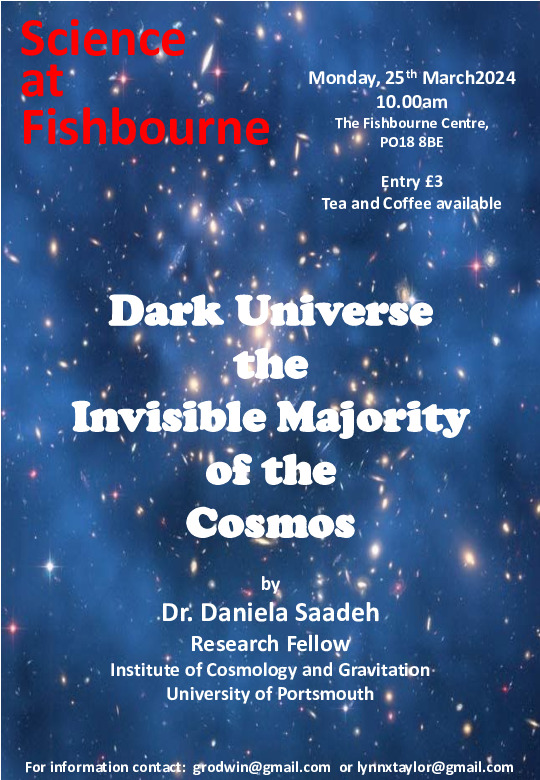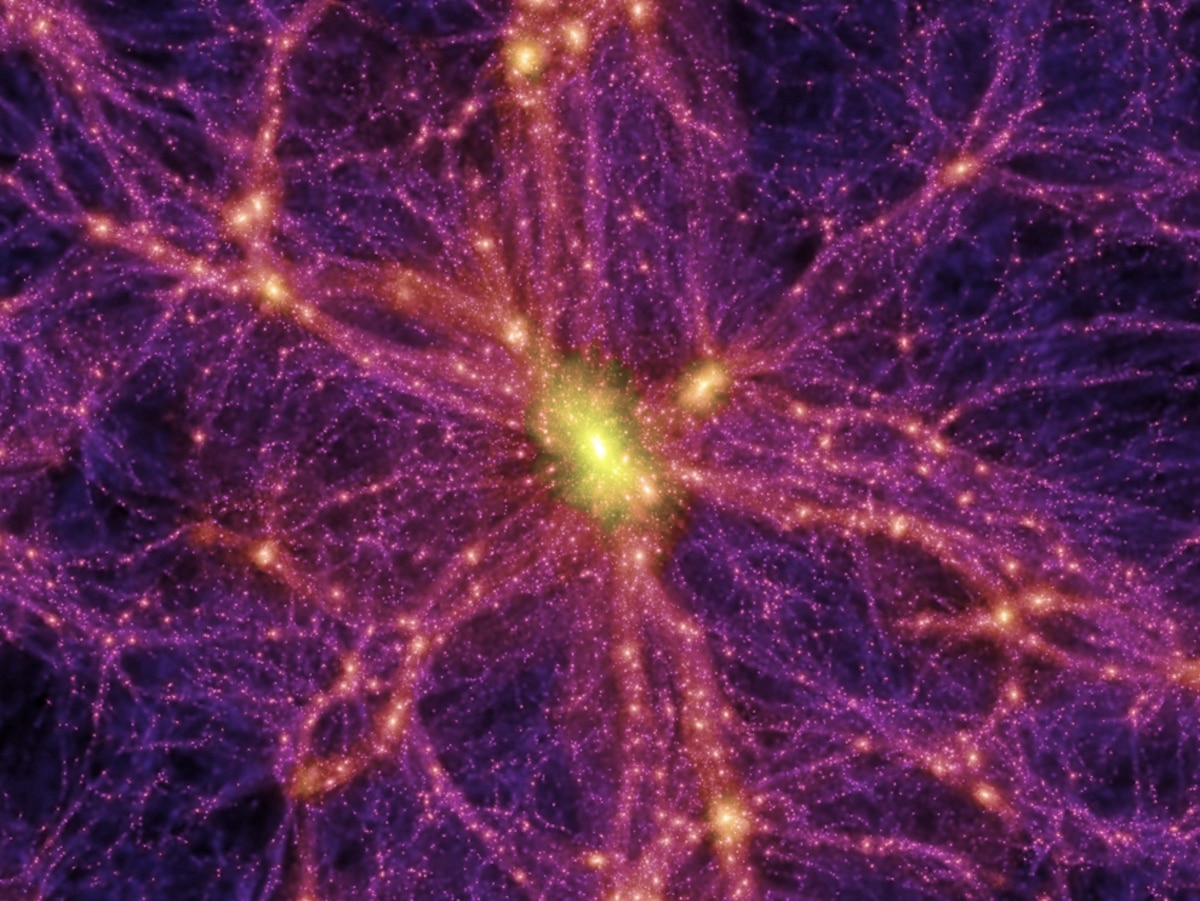
Lynn’s Review
When attempting to write up this complex subject, my first observation is clear: One of the brightest stars in The Universe is Dr Daniela Saadah. Her presentation was eloquent, vibrant and clear and her obvious enthusiasm for her subject was contagious.
Daniela began with the statement that the Universe expands in all directions equally and that she is now using Artificial Intelligence to help find an understanding of Dark Energy.
Her talk was concerned with Dark Matter and Dark Energy.

The word, “Dark,” is used because we cannot see Dark Matter or Dark Energy. Our five senses originate in electromagnetic interactions. Our vision is based on our sensitivity to light. We can see electromagnetic waves that lie within a specific range of frequencies; the narrow band of visible light. The electric charges carried by electrons and protons in the atoms of matter, are the reason that we can see them. These atoms emit or absorb light.
Matter is any material that interacts with gravity, and we can only see Matter that consists of charged particles. Dark Matter has little or no electromagnetic charge and so we cannot see it, so how do we know it’s there?
Daniela gave us examples of hypotheses used in science: In the 1800s it was noticed that the planet Uranus was not following the expected orbit according to Newton’s law of gravity. The hypothesis was that a new planet must be present and must be exerting gravity on Uranus. This led to the discovery of Neptune, and the answer appeared to be clear. However, when the same logic was applied to anomalies with the orbit of Mercury, no other planet was discovered.
Knowing that the elements in the universe, already known and seen, were not affecting the orbit of Mercury, then something unseen must be the cause.
Dark Matter
Daniela highlighted five points which display evidence for the existence of Dark Matter: Rotation curves; Doppler effect; Spectra of elements; Cosmic Microwave background and Bullet Cluster.
Spectra of elements and Doppler effect
Every element has a unique signature/fingerprint because of its composition. The electrons in each element, when excited by photons, absorb and emit wavelengths of light, and because each element’s composition is different, the wavelength of light (therefore visible colour) emitted, is different. In this way, we know the true colour of each element.
We also know that Blue has a high frequency wavelength and so an element will appear closer to us when its light becomes bluer. Red has a low frequency and so elements whose light becomes more red must be further away from us. This is known as the Doppler Effect and applies to sound waves too.
Observations of the light emitted by elements in the universe show that the universe is expanding.
Galaxy Rotation Curves
Light from every point in a galaxy can be measured. In a rotating galaxy, some part of it is moving away and some part moving towards an observer. Vera Rubin, in 1970 measured the velocity of many galaxies.
When looking at the orbits of planets around the sun, those planets closer to the sun orbit faster than those far away. When observing a rotating galaxy, greater velocity would be expected near the central mass; the area of most light, but this is not so. The whole galaxy rotates at a constant speed, and so the hypothesis is that there must be matter that we can’t see, distributed throughout the galaxy and affecting velocity; Dark Matter.
Gravitational Lensing
Modern telescopes using gravitational lensing, can use the light from galactic clusters so magnifying the image. Now light from the earliest galaxies (otherwise unseen) becomes visible. Cosmic Microwave Background Radiation takes us back in time 13.8 billion years to the time of the Big Bang. In the first few minutes after the Big Bang protons and neutrons combined to form the lighter elements, such as hydrogen, helium, lithium, beryllium, and we know how much abundance of each is present. This leaves something unknown, something exotic, yet to be understood, for only 5% of the universe is made from matter consisting of protons and neutrons. 68% may be Dark Energy and 27% Dark Matter.
The Bullet Cluster
In 2004 two clusters of galaxies 3.8 billion light years from Earth, collided and moved past each other. At the time, this event was the most energetic event known to have occurred since the big bang set off the expansion of the universe. When colliding, the normal matter, gas, of the galaxies was in a different place from the Dark Matter; the gas lagged behind and the Dark Matter sailed through the colliding galaxies. Gravitational lensing was used to discern this, and the effect of Dark matter can be seen in multiple places over 3.8 billion years.
Dark Energy
The Hubble Telescope in the 1920s could see from light’s red shift, that the Universe was expanding. Gravity should slow down the rate of expansion, but it is seen to be accelerating.
A type 1A supernova is very bright: When a White Dwarf steals material from a Red Super Giant, it becomes hot and at 1.44 solar masses, it explodes. The light from this event is used to see the velocity of expansion of the universe.
The cause of the acceleration in expansion is being put down to Dark Energy, as this appears to make up 68% of the Universe.
The structure of the Universe, as we know it, is as a cosmic web. More measurements, more data and more questions and answers are needed to further our understanding of it. The Euclid satellite has been launched to take measurements, and Artificial Intelligence is being used to imagine possible images of the Universe using known theories and methods of gravity.
It was comforting to know that Dark Matter, though it is all around us, is not known to react with us, or even with itself and so it is unlikely that there are invisible beings made of Dark Matter sitting beside me as I write this.
Some interesting links:
https://www.nature.com/articles/d41586-018-05096-y
https://chemistrytalk.org/atomic-spectra/
https://spaceplace.nasa.gov/dark-matter/en/
https://spaceplace.nasa.gov/dark-matter/en/
https://www.space.com/gravitational-lensing-explained
https://viewspace.org/interactives/unveiling_invisible_universe/dark_matter/bullet_cluster